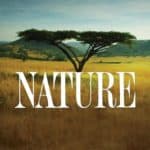A groundbreaking scientific study of gray wolves that is underway in Voyageurs National Park will be featured in an episode of the public television program Nature on Wednesday, May 1. The final episode of the special Springtime in America Live series includes brand new footage of wolf pups in northern Minnesota’s boreal forest.
Watching wolves
In March, University of Minnesota researcher Thomas Gable, working with PBS, deployed a high-definition remote camera at a popular wolf den site in the National Park on Minnesota’s northern border. He said he hoped the den would be used again this spring, and the camera would capture the wolf pups taking their first forays into the wild world around them.
Gable shared this video with PBS from the site, explaining some of his research and the reproductive behavior of wolves.
The program will premiere on Wednesday at 7 p.m. CST. Voyageurs National Park Association is hosting a watch-party in International Falls, and encouraging folks to host their own events and use the hashtag #VoyageursWolves.
Titled “Connections,” this episode spans America from coast-to-coast, showing how plants and animals are interconnected, and how climate change “can break those connections.”
Last week, Voyageurs Wolf Project teased the program with a short clip captured with the den camera, showing a lone adult wolf, possibly an expectant mother, entering the den.
Wolf at a den in Voyageurs National Park
Here is a quick teaser of what the remote cameras we set up at wolf dens in collaboration with Nature | PBS captured. For more amazing footage and the story behind this den make sure to tune in to American Spring Live on PBS at 7:00 pm central on May 1st (in just 6 days!). You will not be disappointed!!
Posted by Voyageurs Wolf Project on Thursday, April 25, 2019
Living laboratory
In a recent post on Nature‘s blog, longtime Voyageurs National Park wildlife biologist and study co-leader Dr. Steve Windels shared an overview of the Park’s wolf studies, and why National Parks are important for science. He points out that there is an “8,000-year streak of wolves howling in” northeastern Minnesota, despite being extirpated from the rest of the Lower 48 states. Since Voyageurs was created by Congress in 1975, the Park Service has been proactive about monitoring its wolf population as a means to track any impacts of hunting.
“Referenced in the title of the influential PBS documentary series “The National Parks: America’s Best Idea,” the model of conservation through the designation of national parks (and other types of protected areas) requires more than just drawing a line on a map, though, in order to conserve wildlife and other biodiversity. It requires consistent monitoring to understand how many individuals are in the population, or whether the population is trending up, down, or staying the same. Such monitoring should also seek to understand how individuals or groups of animals move around within the park, or if and when they may migrate into and out of the areas of protection. A good monitoring program should also know birth dates or the causes of death of species of concern, and what the species eats and how much of that food is available on the landscape.”
The return of wolf hunting was the genesis of the current study, which began in 2012 as gray wolves were briefly removed from the Endangered Species List and a hunting season was created in Minnesota, and ended in 2014. Starting in 2017, Gable started working on his Ph.D., and the study was expanded. It now focuses on wolves’ relationship with their primary prey in the park: moose, deer, and beaver.
Windels says the current study is the longest and most intensive monitoring ever done of wolves at Voyageurs. It has also “quickly proven to be the most productive.”
In addition to learning how wolves hunt beavers, and capturing footage of wolves hunting fish, the project has attracted a large following on Facebook from across the country and around the world. Nearly 14,000 people now follow the page, where researchers regularly post photos, videos, and behind-the-scenes updates on their work.
Now, its outreach has expanded to reach viewers on one of the most-watched nature programs in the history of television. The three-night finale of Nature‘s 37th season on PBS will include live and pre-recorded segments. It will be broadcast on TV and streamed on Facebook, with numerous interactive components. “Nature throws a party every year, and it’s called spring. It is the most active time in the natural world for plants and animals, from birth and rebirth to migrations to pollination,” said Nature executive producer Fred Kaufman. “In addition to witnessing incredible wonders, the goal of Nature: American Spring LIVE is to inspire people to go outside and get involved with science. Everyone can play a part in our natural world.”
How to watch

Springtime in America LIVE
Monday, April 29 – Wednesday, May 1
7 – 8 p.m. on TPT in Minnesota
View schedule »
On Facebook
https://www.facebook.com/PBSNature
Viewing Party
Sammy’s Pizza, International Falls, Minn.
Wednesday, 6:30 p.m. – 8:30 p.m.
Details »

